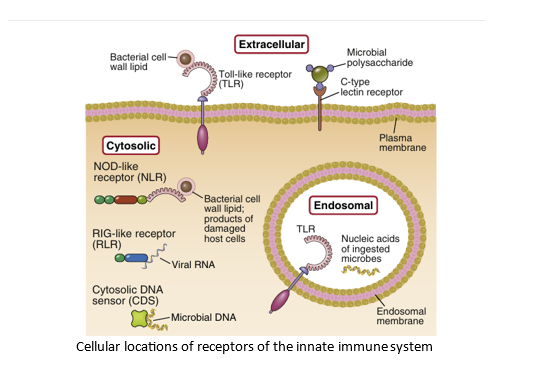


 النبات
النبات
 الحيوان
الحيوان
 الأحياء المجهرية
الأحياء المجهرية
 علم الأمراض
علم الأمراض
 التقانة الإحيائية
التقانة الإحيائية
 التقنية الحيوية المكروبية
التقنية الحيوية المكروبية
 التقنية الحياتية النانوية
التقنية الحياتية النانوية
 علم الأجنة
علم الأجنة
 الأحياء الجزيئي
الأحياء الجزيئي
 علم وظائف الأعضاء
علم وظائف الأعضاء
 الغدد
الغدد
 المضادات الحيوية
المضادات الحيوية|
أقرأ أيضاً
التاريخ: 26-9-2018
التاريخ: 15-3-2017
التاريخ: 6-1-2020
التاريخ: 9-3-2017
|
Toll-like receptors (TLRs) are homologous to a Drosophila protein called Toll, which was discovered for its role in the development of the fly and later shown to be essential for protecting flies against fungal infections. In vertebrates, there are 10 different TLRs specific for different components of microbes. TLR-2 recognizes several glycolipids and peptidoglycans that are made by gram-positive bacteria and some parasites; TLR-3 is specific for double-stranded RNA, and TLR-7 and TLR-8 are specific for single-stranded RNA; TLR-4 is specific for bacterial LPS (endotoxin), made by gram-negative bacteria; TLR-5 is specific for a bacterial flagellar protein called flagellin; and TLR-9 recognizes unmethylated CpG DNA, which is abundant in microbial genomes. TLRs specific for microbial proteins, lipids, and polysaccharides (many of which are present in bacterial cell walls) are located on cell surfaces, where they recognize these products of extracellular microbes. TLRs that recognize nucleic acids are in endosomes, into which microbes are ingested and where they are digested and their nucleic acids are released.
Signals generated by TLRS activate transcription factors that stimulate expression of cytokines and other proteins involved in the inflammatory response and in the antimicrobial functions of activated phagocytes and other cells. Among the most important transcription factors activated by TLR signals are members of the nuclear factor KB (NF-kB) family, which promote expression of various cytokines and endothelial adhesion molecules that play important roles in inflammation, and interferon regulatory factors (IRFs), which stimulate production of the antiviral cytokines, type I interferons.
Rare autosomal recessive diseases characterized by recurrent infections are caused by mutations affecting TLRs or their signaling molecules, highlighting the importance of these pathways in host defense against microbes. For example, individuals with mutations affecting TLR-3 are susceptible to herpes simplex virus infections, particularly encephalitis, and mutations in MyD88, the adaptor protein downstream of several TLRs, make individuals susceptible to bacterial pneumonias.




|
|
|
|
دراسة: حفنة من الجوز يوميا تحميك من سرطان القولون
|
|
|
|
|
|
|
تنشيط أول مفاعل ملح منصهر يستعمل الثوريوم في العالم.. سباق "الأرنب والسلحفاة"
|
|
|
|
|
|
|
لتعزيز التواصل مع الزائرات الأجنبيات : العتبة العلويّة المقدّسة تُطلق دورة لتعليم اللغة الإنجليزية لخادمات القسم النسويّ
|
|
|